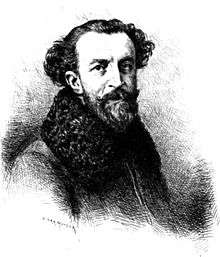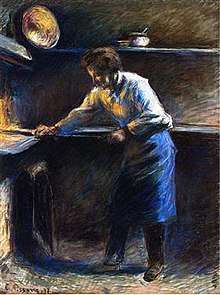Eugène Murer
Hyacinthe-Eugène Meunier (15 May 1841 – 22 April 1906), known as Eugène Murer, was a pastry chef, author, self-taught painter and collector of impressionist paintings.[1][2] [3]
Eugène Murer | |
|---|---|
 | |
| Born | Hyacinthe-Eugène Meunier |
| Died | April 22, 1906 (aged 64) |
| Movement | Impressionism |
He was born in Moulins or Poitiers on 15 or 20 May 1846. He was a childhood friend of Armand Guillaumin, who introduced him to the impressionists.[4] He was an apprentice pastry chef at Grû at 8 Rue du Faubourg-Montmartre and 125 Faubourg Poissonnière.[5][6]
He ran a patisserie at 95 Boulevard Voltaire, where he invited, for "Tuesday-dinner", young artists, collectors, and established artists. Renoir, Sisley, Monet, Cézanne, Gachet, Vincent and Theo Van Gogh, Père Tanguy, art dealers Louis Legrand and Alphonse Portier, Goeneutte, Guillaumin, Vignon, Pierre Franc-Lamy, and Pissarro were among his guests.[7]
He died in Auvers-sur-Oise, where he was neighbour to Gachet,[1] on 22 April 1906.[8]
He lived on 39 rue Victor Massé, Paris, above a carpenter and art supply dealer called Michel, where he bought his paints.[7]
The Musée d'Orsay owns one of his paintings, L'Oise at Isle-Adam, from 1903.[9]
Bibliography
He published under the pseudonym Gêne-Mûr.
- Comment Se Vengent Les Batards; 1865 [10][11]
- Les Fils du siècle; 1877
- Pauline Lavinia; 1887[12]
- La mère Nom de Dieu! 1888[13]
An 1877 portrait of Eugène Murer by Renoir is in the collection of the Metropolitan Museum of Art.[1]
A portrait by Camille Pissarro from 1878 is in the collection of the Museum of Fine Arts in Springfield, Massachusetts.
References
- "Eugène Murer (Hyacinthe-Eugène Meunier, 1841–1906)". www.metmuseum.org. Retrieved 2018-08-12.
- Montaigne, Jean-Marc (2010). Eugène Murer: un ami oublié des impressionnistes : Paris, Auvers-sur-Oise, Rouen (in French). ASI Éd. ISBN 9782912461131.
- Gachet, Paul (1956). Le Docteur Gachet et Murer: deux amis des impressionnistes (in French). Éditions de Musées nationaux.
- AMA. "Armand Guillaumin,_CHRONOLOGIE - La Lettre de l'AMA". La Lettre de l'AMA (in French). Retrieved 2018-08-12.
- Vassor, Bernard. "Sur les pas des écrivains : Le café Wolff et le pâtissier Grû". www.terresdecrivains.com (in French). Retrieved 2018-08-12.
- VALLEE, Jean-Pierre. "Le docteur Gachet fou de peinture". www.van-gogh.fr (in French). Retrieved 2018-08-12.
- "La Maison des Associations du 9ème - Action Barbès". actionbarbes.blogspirit.com (in French). Retrieved 2018-08-12.
- "Eugène Murer – Moulins (1846) – Auvers-sur-Oise (1906) - Auvers-sur-Oise et Vincent van Gogh". Auvers-sur-Oise et Vincent van Gogh (in French). 2010-03-02. Retrieved 2018-08-12.
- "Musée d'Orsay: Collections catalogue - search results". www.musee-orsay.fr. Retrieved 2018-08-12.
- texte, Murer, Eugène (1841-1906). Auteur du (1865). "Comment se vengent les bâtards, par Eugène Murer". Gallica. Retrieved 2018-08-12.
- MURER, Eugène (1865). Comment se vengent les bâtards (in French). Paris.
- Murer, Eugène (1887). Pauline Lavinia (in French). Paris: J. Lévy.
- Murer, Eugène (1888). La Mère nom de Dieu ; [La Brûleuse] ; [Les Poules noires] ; [L'Araignée du coin] ; [Un Rève de bourreau] ; [Un Quart d'heure d'amour] ; [Mam'selle Fleurette (in French). Paris: J. Lévy.
